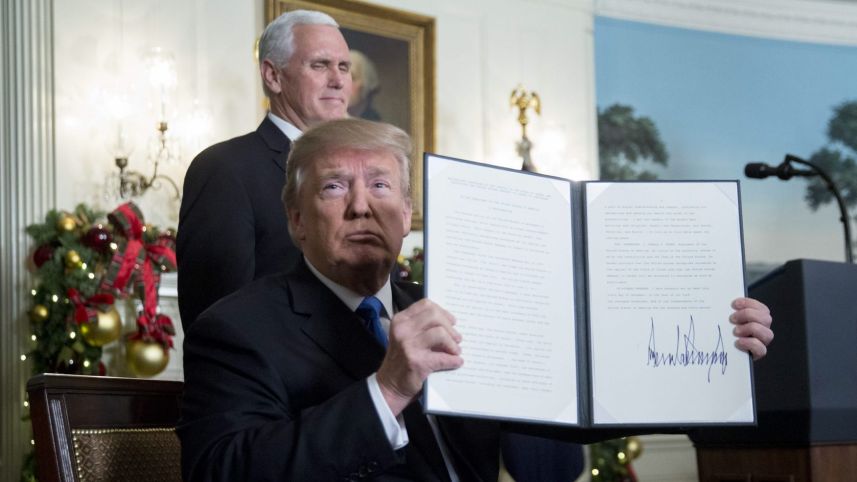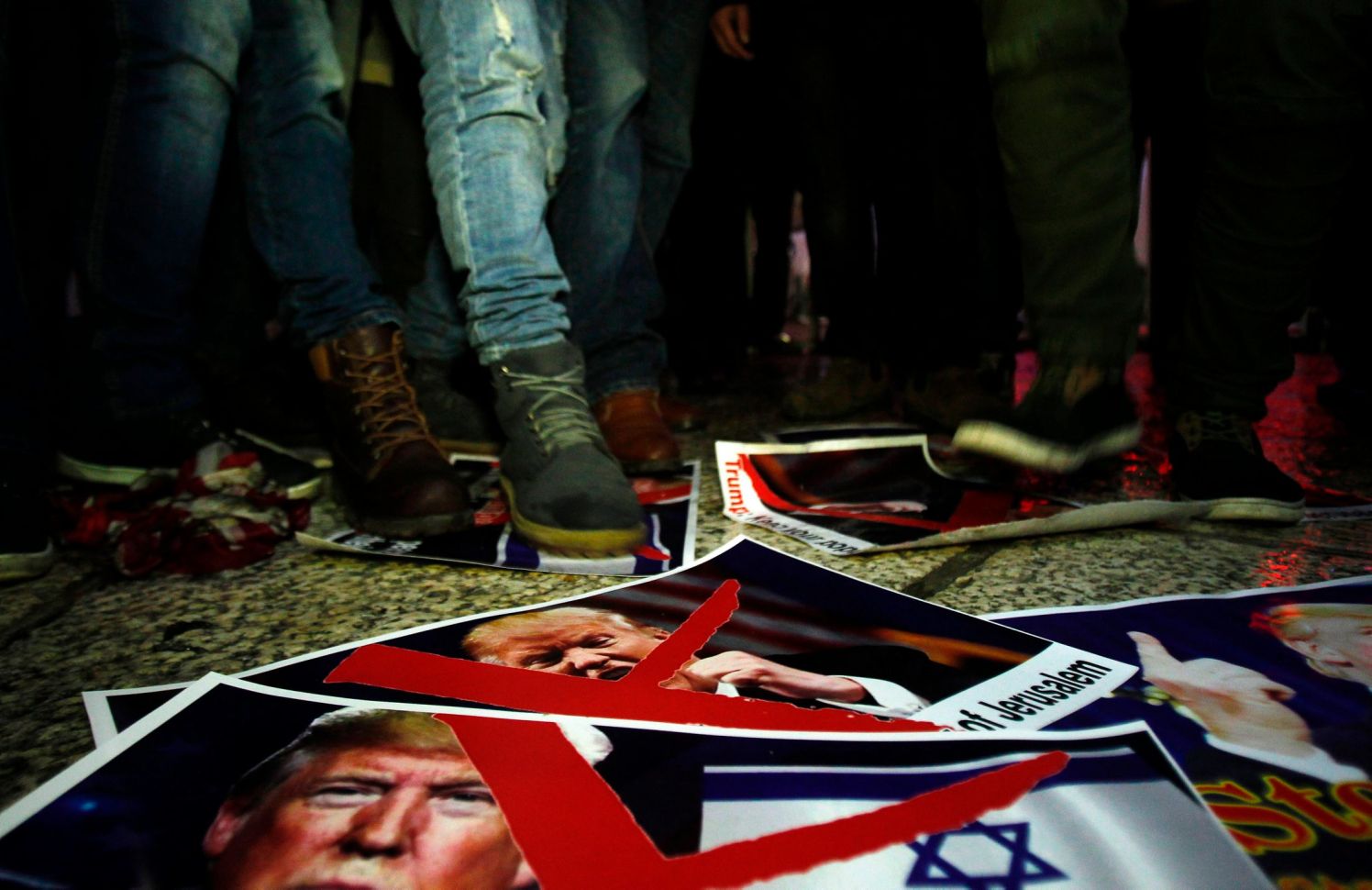By: Daniel B. Shapiro
Trump's Jerusalem move, taken and rolled out in a frantic rush, stopped at mere rhetoric for Israel and nothing for Palestinians. Kushner and Greenblatt must show far more explicit U.S. support for two states - and it needs to happen soon

President Donald Trump holds up a signed memorandum recognizing U.S. recognition of Jerusalem as Israel's capital, White House in Washington, D.C. Dec. 6, 2017 Credit: Andrew Harrer/Bloomberg
Let’s dispense with the heavy breathing. President Donald Trump’s announcement Wednesday recognizing the reality that Jerusalem is Israel’s capital is neither the end of efforts to achieve Middle East peace nor the second coming of Harry Truman’s recognition of the newly-declared State of Israel.
But it was a missed opportunity in two respects.
First, President Trump stopped at a merely rhetorical change. True, recognition of Jerusalem as Israel’s capital is new, something no U.S. Administration of either party had yet articulated. It helps combat the insidious fiction, trafficked by some Palestinians and prominent in UNESCO resolutions and the like, that there are no legitimate Jewish and Israeli claims to Jerusalem. Myth-busting has its merits.

In front of a mural depicting Jerusalem's Dome of the Rock, a Palestinian man sweeps the street in Hebron in the Israeli-occupied West Bank. December 7, 2017 Credit: AFP PHOTO / HAZEM BADER
But the decision at hand was about the location of the U.S. embassy. Having made the rhetorical shift, Trump passed up on its more substantive manifestation by delaying transferring the embassy to Jerusalem. Indeed, he punctuated his speech by signing the waiver of the law that requires the move - just like his predecessors.
My views on the embassy’s location are informed by my experience as U.S. Ambassador. I worked at the U.S. embassy on HaYarkon Street in Tel Aviv for over five years. I had a beautiful view of the Mediterranean from my office. It will be hard for any Ambassador to give that up. But nearly every day, I got in my armored SUV and traveled to Jerusalem where I conducted affairs of state in the offices of the Israeli government - the Prime Minister’s office, the President’s residence, the Knesset.
When President Obama visited Israel in 2013, he stayed at the King David Hotel and visited the same government sites. Secretaries of State routinely base their visits in Jerusalem as well. So the location of our embassy in West Jerusalem - about which there is, or should not be, any controversy about Israel’s past and future sovereignty - is logical and right.
The United States has consular facilities in West Jerusalem that could easily house an embassy on a temporary basis, starting tomorrow, even while many functions remain in Tel Aviv. But President Trump limited himself to announcing plans to begin preparations for an embassy move, suggesting it will take at least 3-4 years to complete a new embassy.
That’s an extremely optimistic estimate. Constructing a new embassy is a complex undertaking. It is far more likely to take 5-10 years, and tens if not hundreds of millions of dollars, to locate a suitable property, plan and build an embassy to security standards, and arrange for the housing and schooling of hundreds of U.S. diplomats and their families.
The strong implication of Trump’s announcement is that he will continuing issuing waivers every six months for years to come. His successor may well be the one to preside at its dedication.

A giant U.S. flag screened alongside Israel's national flag by the Jerusalem municipality on the walls of the Old City. December 6, 2017 Credit: AFP PHOTO / Ahmad GHARABLI
The second missed opportunity was in failing to frame this announcement in the context of efforts to advance the broader strategic U.S. objective of a two-state solution.
In addition to recognizing Jerusalem as Israel’s capital and moving the embassy to West Jerusalem, Trump should have made clear that East Jerusalem has a different status, will need to be negotiated, and the United States expects that the results will include the capital of a Palestinian state in at least parts of its Arab neighborhoods.
We don’t need to define the exact dimensions of the shared city. Acceptable arrangements on holy sites, such as Israeli sovereignty at the Western Wall and maintenance of the status quo at the Temple Mount/Haram al-Sharif, are necessary. And the city must remain unified, never again redivided by checkpoints and barbed wire.
But such clarity about the future of Jerusalem as a shared, unified city containing the capitals of both Israel and Palestine would usefully bust another myth - that a two-state solution to end the conflict can be achieved without such an arrangement. Recognition of this reality is useful as well.
Trump also could have helped himself by planning this decision well in advance, not in the frantic, hurried fashion in which it was taken and rolled out.
Adequate preparations, like detailed consultations with Arab and Palestinian leaders, would have made it easier for them to absorb, and more likely for them to be able to support a U.S. peace plan when it is revealed. That support is now in jeopardy. Violence as a means of protest is unacceptable, as is incitement to violence, and we cannot be blackmailed by it. But preparation and clarity would have made it easier for our Arab partners to effectively resist such calls.

Palestinian demonstrators stand on posters of the U.S. president and the Israeli flag in Bethlehem's Manger Square in protest to him declaring Jerusalem as Israel's capital. December 6, 2017 Credit: AFP PHOTO / Musa AL SHAER
It’s not too late to improve on this announcement.
In his speech, Trump teased his openness to a two-state solution for the first time, albeit with the caveat that it must be agreed to by both sides. But the U.S. interest lies squarely in an end-of-conflict agreement, which can only be achieved with two states. It may take many years, and it may await the emergence of new leaders who can take decisions the current crop cannot.
But if we fail to use this period to keep the two-state solution alive, Trump will go down as the president who did nothing while Israelis and Palestinians drifted into the morass of a binational state.
In his interview at the Saban Forum this week, Trump’s senior adviser Jared Kushner gave nothing away about the plan he and Middle East envoy Jason Greenblatt have been preparing. They have no obligation to do so before they are ready, and discretion has its virtues.
But the time is coming for them to present their approach. They should build off Trump’s Jerusalem announcement this week with a plan that is as explicit as possible about the goal of a two-state solution on a realistic basis.
Negotiations may be impossible in the near term, even with the presentation of such a plan. But it will serve as an anchor to keep the U.S., Israeli, Palestinian, and regional interest of a two-state solution alive until such time as improved leadership dynamics permit such negotiations to proceed. And it will provide a framework for Israelis, Palestinians and Arab states to take the practical economic, security, and political steps on the ground that require no negotiations but are consistent with a two-state solution.